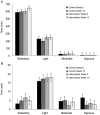Twelve weeks of dance exergaming in overweight and obese adolescent girls: Transfer effects on physical activity, screen time, and self-efficacy
- PMID: 28491483
- PMCID: PMC5421642
- DOI: 10.1016/j.jshs.2016.11.005
Twelve weeks of dance exergaming in overweight and obese adolescent girls: Transfer effects on physical activity, screen time, and self-efficacy
Abstract
Background: Given the low levels of physical activity (PA) among adolescent girls in the US, there is a need to identify tools to motivate increased PA. Although there is limited evidence that adolescents transfer PA from one context to another context, exergames (i.e., video games that require gross motor activity) may act as a gateway to promote overall PA outside of game play. The purpose of this study was to examine potential transfer effects (i.e., influences on external behaviors and psychological constructs) of a 12-week exergaming intervention on adolescent girls' PA, screen-time, and self-efficacy towards PA, as well as the intrinsic motivation of exergaming.
Methods: Participants were 37 girls aged 14-18 years (65% African American, 35% White) who were overweight or obese (body mass index ≥ 85th percentile) and were recruited from the community via school, physicians, news media, and social media sites. Adolescents were randomly assigned to a 12-week group exergaming intervention (thirty-six 60 min sessions of group-based dance exergaming in a research laboratory using Kinect for Xbox 360) or to a no-treatment control group. Outcome variables included objectively measured PA (total) and self-reported leisure-time PA (discretionary time only) 1-week before vs. 1-week after the intervention; selected type and intensity of PA when placed in a gym setting for 30 min ("cardio free choice"); screen-time; self-efficacy towards PA; and intrinsic motivation towards exergaming.
Results: Attendance to the exergaming sessions was high (80%). Compared to the control group, the intervention group self-reported an increase in PA (p = 0.035) and fewer hours watching TV/videos (p = 0.01) after the intervention, but there were no significant differences in sedentary, light, moderate, or vigorous PA measured by accelerometry. The intervention group significantly improved self-efficacy towards PA (p = 0.028). The intervention group highly rated intrinsic motivation towards exergaming.
Conclusion: Twelve weeks of exergaming was associated with positive impacts on adolescent girls' self-reported PA, television viewing, self-efficacy, and intrinsic motivation. Future research is warranted to leverage exergames as an enjoyable, motivating, and effective PA tool.
Keywords: Active video games; Leisure activity; Motivation; Screen-time; Self-efficacy; Television.
Figures
Similar articles
-
Small-Groups Versus Full-Class Exergaming on Urban Minority Adolescents' Physical Activity, Enjoyment, and Self-Efficacy.J Phys Act Health. 2021 Feb 1;18(2):192-198. doi: 10.1123/jpah.2020-0348. Epub 2021 Jan 12. J Phys Act Health. 2021. PMID: 33440345
-
Comparative Effectiveness of a 12-Week Physical Activity Intervention for Overweight and Obese Youth: Exergaming with "Dance Dance Revolution".Games Health J. 2012 Apr;1(2):96-103. doi: 10.1089/g4h.2011.0009. Epub 2012 Jan 5. Games Health J. 2012. PMID: 26193183
-
A 12-week randomized controlled pilot study of dance exergaming in a group: Influence on psychosocial factors in adolescent girls.Cyberpsychology (Brno). 2018;12(2):3. doi: 10.5817/CP2018-2-3. Cyberpsychology (Brno). 2018. PMID: 31367239 Free PMC article.
-
Can Active Video Games Improve Physical Activity in Adolescents? A Review of RCT.Int J Environ Res Public Health. 2020 Jan 20;17(2):669. doi: 10.3390/ijerph17020669. Int J Environ Res Public Health. 2020. PMID: 31968642 Free PMC article.
-
Better Together: Outcomes of Cooperation Versus Competition in Social Exergaming.Games Health J. 2015 Feb;4(1):25-30. doi: 10.1089/g4h.2014.0066. Epub 2014 Oct 17. Games Health J. 2015. PMID: 26181677 Free PMC article. Review.
Cited by
-
Adolescent Physical Activity at Public Schools, Private Schools, and Homeschools, United States, 2014.Prev Chronic Dis. 2020 Aug 20;17:E85. doi: 10.5888/pcd17.190450. Prev Chronic Dis. 2020. PMID: 32816666 Free PMC article.
-
Acute Effects of Immersive Virtual Reality Exercise on Young Adults' Situational Motivation.J Clin Med. 2019 Nov 12;8(11):1947. doi: 10.3390/jcm8111947. J Clin Med. 2019. PMID: 31726672 Free PMC article.
-
Can Gaming Get You Fit?Front Physiol. 2020 Aug 20;11:1017. doi: 10.3389/fphys.2020.01017. eCollection 2020. Front Physiol. 2020. PMID: 32973553 Free PMC article.
-
Comparison of College Students' Energy Expenditure, Physical Activity, and Enjoyment during Exergaming and Traditional Exercise.J Clin Med. 2018 Nov 10;7(11):433. doi: 10.3390/jcm7110433. J Clin Med. 2018. PMID: 30423805 Free PMC article.
-
Fight fire with fire? Promoting physical activity and health through active video games.J Sport Health Sci. 2017 Mar;6(1):1-3. doi: 10.1016/j.jshs.2016.11.009. Epub 2016 Nov 24. J Sport Health Sci. 2017. PMID: 30356540 Free PMC article. No abstract available.
References
-
- The Nielsen Company A look across media: the cross-platform report, the Cross-Platform Series Q3 2013. 2013. http://www.nielsen.com/content/dam/corporate/us/en/reports-downloads/201... Available at: [accessed 09.01.2017]
-
- Troiano R.P., Berrigan D., Dodd K.W., Masse L.C., Tilert T., McDowell M. Physical activity in the United States measured by accelerometer. Med Sci Sports Exerc. 2008;40:181–188. - PubMed
-
- Shay C.M., Ning H., Daniels S.R., Rooks C.R., Gidding S.S., Lloyd-Jones D.M. Status of cardiovascular health in US adolescents: prevalence estimates from the National Health and Nutrition Examination Surveys (NHANES) 2005–2010. Circulation. 2013;127:1369–1376. - PubMed
-
- May A.L., Kuklina E.V., Yoon P.W. Prevalence of cardiovascular disease risk factors among US adolescents, 1999−2008. Pediatrics. 2012;129:1035–1041. - PubMed
-
- Shephard R. Future directions in health and fitness. In: Shephard R., editor. Vol. 39. Springer International Publishing; New York, NY: 2015. pp. 1065–1077. (An illustrated history of health and fitness, from pre-history to our post-modern world).
Grants and funding
LinkOut - more resources
Full Text Sources
Other Literature Sources
Medical
Miscellaneous


